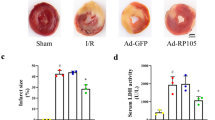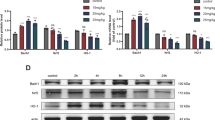Abstract
Objective
To investigate whether ginsenoside-Rb1 (Gs-Rb1) improves the CoCl-induced autophagy of cardiomyocytes via upregulation of adenosine 5′-monophosphate-activated protein kinase (AMPK) pathway.
Methods
Ventricles from 1- to 3-day-old Wistar rats were sequentially digested, separated and incubated in Dulbecco’s modified Eagle’s medium supplemented with 10% fetal bovine serum for 3 days followed by synchronization. Neonatal rat cardiomyocytes were randomly divided into 7 groups: control group (normal level oxygen), hypoxia group (500 μmol/L CoCl2), Gs-Rb1 group (200 μmol/L Gs-Rb1 + 500 μmol/L CoCl2), Ara A group (500 μmol/L Ara A + 500 μmol/L CoCl2), Ara A+ Gs-Rb1 group (500 μmol/L Ara A + 200 μmol/L Gs-Rb1 + 500 μmol/L CoCl2), AICAR group [1 mmol/L 5-aminoimidazole-4-carboxamide ribonucleotide (AICAR) + 500 μmol/L CoCl2], and AICAR+Gs-Rb1 group (1 mmol/L AICAR + 200 μmol/L Gs-Rb1 + 500 μmol/L CoCl2). Cells were treated for 12 h and cell viability was determined by methylthiazolyldiphenyl-tetrazolium bromide (MTT) assay and cardiac troponin I (cTnI) levels were detected by enzyme-linked immunosorbent assay (ELISA). AMPK activity was assessed by 2′,7′-dichlorofluorescein diacetate (DCFH-DA) ELISA assay. The protein expressions of Atg4B, Atg5, Atg6, Atg7, microtubule-associated protein 1A/1B-light chain 3 (LC3), P62, and active-cathepsin B were measured by Western blot.
Results
Gs-Rb1 significantly improved the cell viability of hypoxia cardiomyocytes (P<0.01). However, the viability of hypoxia-treated cardiomyocytes was significantly inhibited by Ara A (P<0.01). Gs-Rb1 increased the AMPK activity of hypoxia-treated cardiomyocytes. The AMPK activity of hypoxia-treated cadiomyocytes was inhibited by Ara A (P<0.01) and was not affected by AICAR =0.983). Gs-Rb1 up-regulated Atg4B, Atg5, Beclin-1, Atg7, LC3B II, the LC3B II/I ratio and cathepsin B activity of hypoxia cardiomyocytes (P<0.05), each of these protein levels was significantly enhanced by Ara A (all P<0.01), but was not affected by AICAR (all P>0.05). Gs-Rb1 significantly down-regulated P62 levels of hypoxic cardiomyocytes (P<0.05). The P62 levels of hypoxic cardiomyocytes were inhibited by Ara A (P<0.05) and were not affected by AICAR (P=0.871).
Conclusion
Gs-Rb1 may improve the viability of hypoxia cardiomyocytes by ameliorating cell autophagy via the upregulation of AMPK pathway.
Similar content being viewed by others
References
Shintani T, Klionsky DJ. Autophagy in health and disease: a double-edged sword. Science 2004;306:990–995.
Yan L, Vatner DE, Kim SJ, Ge H, Masurekar M, Massover WH, et al. Autophagy in chronically ischemic myocardium. Proc Natl Acad Sci U S A 2005;12:13807–13812.
Hamacher-Brady A, Brady NR, Gottlieb RA. Enhancing macroautophagy protects against ischemia/reperfusion injury in cardiac myocytes. J Biol Chem 2006;28:29776–29787.
Dosenko VE, Nagibin VS, Tumanovska LV, Moibenko AA. Protective effect of autophagy in anoxia-reoxygenation of isolated cardiomyocyte. Autophagy 2006;2:305–306.
Matsui Y, Takagi H, Qu X, Abdellatif M, Sakoda H, Asano T, et al. Distinct roles of autophagy in the heart during ischemia and reperfusion: roles of AMP-activated protein kinase and Beclin 1 in mediating autophagy. Circ Res 2007;100:914–922.
Gui L, Liu B, Lu G. Hypoxia induces autophagy in cardiomyocytes via a hypoxia-inducible factor 1-dependent mechanism. Exp Ther Med 2016;11:2233–2239.
Jiang QS, Huang XN, Yang GZ, Jiang XY, Zhou QX. Inhibitory effect of ginsenoside Rb1 on calcineurin signal pathway in cardiomyocyte hypertrophy induced by prostaglandin F2alpha. Acta Pharmacol Sin (Chin) 2007;28:1149–1154.
Kong HL, Wang JP, Li ZQ, Zhao SM, Dong J, Zhang WW. Anti-hypoxic effect of ginsenoside Rb1 on neonatal rat cardiomyocytes is mediated through the specific activation of glucose transporter-4 ex vivo. Acta Pharmacol Sin (Chin) 2009;30:396–403.
Kong HL, Li ZQ, Zhao YJ, Zhao SM, Zhu L, Li T, et al. Ginsenoside Rb1 protects cardiomyocytes against CoCl2-induced apoptosis in neonatal rats by inhibiting mitochondria permeability transition pore opening. Acta Pharmacol Sin (Chin) 2010;31:687–695.
Kong HL, Li ZQ, Zhao SM, Yuan L, Miao ZL, Liu Y, et al. Apelin-APJ effects of ginsenoside-Rb1 depending on hypoxia-induced factor 1α in hypoxia neonatal cardiomyocytes. Chin J Integr Med 2015;21:139–146.
Boya P, Gonzalez-Polo RA, Casares N, Perfettini JL, Dessen P, Larochette N, et al. Inhibition of macroautophagy triggers apoptosis. Mol Cell Biol 2005;25:1025–1040.
Kim I, Rodriguez-Enriquez S, Lemasters JJ. Selective degradation of mitochondria by mitophagy. Arch Biochem Biophys 2007;462:245–253.
Levine B, Yuan J. Autophagy in cell death: an innocent convict? J Clin Invest 2005;115:2679–2688.
Thorburn A. Apoptosis and autophagy: regulatory connections between two supposedly different processes. Apoptosis 2008;13:1–9.
Maiuri MC, Zalckvar E, Kimchi A, Kroemer G. Selfeating and self-killing: crosstalk between autophagy and apoptosis. Nat Rev Mol Cell Biol 2007;8:741–752.
Espert L, Denizot M, Grimaldi M, Robert-Hebmann V, Gay B, Varbanov M, et al. Autophagy is involved in T cell death after binding of HIV-1 envelope proteins to CXCR4. J Clin Invest 2006;116: 2161–2172.
Moretti L, Cha YI, Niermann KJ, Lu B. Switch between apoptosis and autophagy: radiation-induced endoplasmic reticulum stress? Cell Cycle 2007;6:793–798.
Boyce M, Yuan J. Cellular response to endoplasmic reticulum stress: a matter of life or death. Cell Death Differ 2006;13:363–373.
Kimura S, Noda T, Yoshimori T. Dissection of the autophagosome maturation process by a novel reporter protein, tandem fluorescent-tagged LC3. Autophagy 2007;3:452–460.
Xie Z, Nair U, Klionsky DJ. Atg8 controls phagophore expansion during autophagosome formation. Mol Biol Cell 2008;19:3290–3298.
Mizushima N, Yamamoto A, Hatano M, Kobayashi Y, Kabeya Y, Suzuki K, et al. Dissection of autophagosome formation using Apg5-deficient mouse embryonic stem cells. J Cell Biol 2001;152:657–668.
Kihara A, Kabeya Y, Ohsumi Y, Yoshimori T. Beclinphosphatidylinositol 3-kinase complex functions at the trans-Golgi network. EMBO Rep 2001;2:330–335.
Matsui Y, Takagi H, Qu X, Abdellatif M, Sakoda H, Asano T, et al. Distinct roles of autophagy in the heart during ischemia and reperfusion: roles of AMP-activated protein kinase and Beclin 1 in mediating autophagy. Circ Res 2007;100:914–922.
Valentim L, Laurence KM, Townsend PA, Carroll CJ, Soond S, Scarabelli TM, et al. Urocortin inhibits Beclin1- mediated autophagic cell death in cardiac myocytes exposed to ischaemia/reperfusion injury. J Mol Cell Cardiol 2006;40:846–852.
Ma X, Liu H, Foyil SR, Godar RJ, Weinheimer CJ, Hill JA, et al. Impaired autophagosome clearance contributes to cardiomyocyte death in ischemia/reperfusion injury. Circulation 2012;125:3170–3181.
Zeng M, Wei X, Wu Z, Li W, Li B, Zhen Y, et al. NF-κBmediated induction of autophagy in cardiac ischemia/ reperfusion injury. Biochem Biophys Res Commun 2013;436:180–185.
Feng Y, Yao Z, Klionsky DJ. How to control self-digestion: transcriptional, post-transcriptional, and post-translational regulation of autophagy. Trends Cell Biol 2015;25:354–363.
Nakatogawa H, Suzuki K, Kamada Y, Ohsumi Y. Dynamics and diversity in autophagy mechanisms: lessons from yeast. Nat Rev Mol Cell Biol 2009;10:458–467.
Shintani T, Huang WP, Stromhaug PE, Klionsky DJ. Mechanism of cargo selection in the cytoplasm to vacuole targeting pathway. Dev Cell 2002;3:825–837.
Xie Z, Nair U, Klionsky DJ. Atg8 controls phagophore expansion during autophagosome formation. Mol Biol Cell 2008;19:3290–3298.
Kaufmann A, Beier V, Franquelim HG, Wollert T. Molecular mechanism of autophagic membrane-scaffold assembly and disassembly. Cell 2014;156:469–481.
Zhang J, He Z, Xiao W, Na Q, Wu T, Su K, et al. Overexpression of BAG3 attenuates hypoxia-induced cardiomyocyte apoptosis by inducing autophagy. Cell Physiol Biochem 2016;39:491–500.
Gao YH, Qian JY, Chen ZW, Fu MQ, Xu JF, Xia Y, et al. Suppression of Bim by microRNA-19a may protect cardiomyocytes against hypoxia-induced cell death via autophagy activation. Toxicol Lett 2016;257:72–83.
Hsieh DJ, Kuo WW, Lai YP, Shibu MA, Shen CY, Pai P, et al. 17β-Estradiol and/or estrogen receptor β attenuate the autophagic and apoptotic effects induced by prolonged hypoxia through HIF-1α-mediated BNIP3 and IGFBP-3 signaling blockage. Cell Physiol Biochem 2015;36:274–284.
Komatsu M, Kageyama S, Ichimura Y. P62/SQSTM1/A170: physiology and pathology. Pharmacol Res 2012;66:457–462.
Layfield R, Cavey JR, Najat D, Long J, Sheppard PW, Ralston SH, et al. p62 mutations, ubiquitin recognition and Paget’s disease of bone. Bio Soc Trans 2006;34:735–737.
Lee JH, Yu WH, Kumar A, Lee S, Mohan PS, Peterhoff CM, et al. Lysosomal proteolysis and autophagy require presenilin 1 and are disrupted by Alzheimer-related PS1 mutations. Cell 2010;141:1146–1158.
Moscat J, Diaz-Meco MT, Wooten MW. Signal integration and diversification through the p62 scaffold protein. Trends Biol Sci 2007;32:95–100.
Pankiv S, Clausen TH, Lamark T, Brech A, Bruun JA, Outzen H, et al. p62/SQSTM1 binds directly to Atg8/LC3 to facilitate degradation of ubiquitinated protein aggregates by autophagy. J Biol Chem 2007;282:24131–24145.
Mizushima N, Hara T. Intracellular quality control by autophagy: how does autophagy prevent neurodegeneration? Autophagy 2006;2:302–304.
Bjørkøy G, Lamark T, Brech A, Outzen H, Perander M, Overvatn A, et al. p62/SQSTM1 forms protein aggregates degraded by autophagy and has a protective effect on huntingtin-induced cell death. J Cell Biol 2005;171:603–614.
Wang Q, Yang L, Hua Y, Nair S, Xu X, Ren J. AMP-activated protein kinase deficiency rescues paraquat-induced cardiac contractile dysfunction through an autophagy-dependent mechanism. Toxicol Sci 2014;142:6–20.
Inoki K, Zhu T, Guan KL. TSC2 mediates cellular energy response to control cell growth and survival. Cell 2003;115:577–590.
Tripathi DN, Chowdhury R, Trudel LJ, Tee AR, Slack R S, Walker CL, et al. Reactive nitrogen species regulate autophagy through ATM-AMPK-TSC2-mediated suppression of mTORC1. Proc Natl Acad Sci U S A 2013;110: E2950–E2957.
Author information
Authors and Affiliations
Corresponding author
Additional information
Supported by Shenyang Innovation Foundation of Science and Technology-the Application Projects of Basic Research (No. F15-199-1-06), Liaoning Province Science and Technique Foundation of China (No. 2015020282)
Rights and permissions
About this article
Cite this article
Dai, Sn., Hou, Aj., Zhao, Sm. et al. Ginsenoside Rb1 Ameliorates Autophagy of Hypoxia Cardiomyocytes from Neonatal Rats via AMP-Activated Protein Kinase Pathway. Chin. J. Integr. Med. 25, 521–528 (2019). https://doi.org/10.1007/s11655-018-3018-y
Accepted:
Published:
Issue Date:
DOI: https://doi.org/10.1007/s11655-018-3018-y




